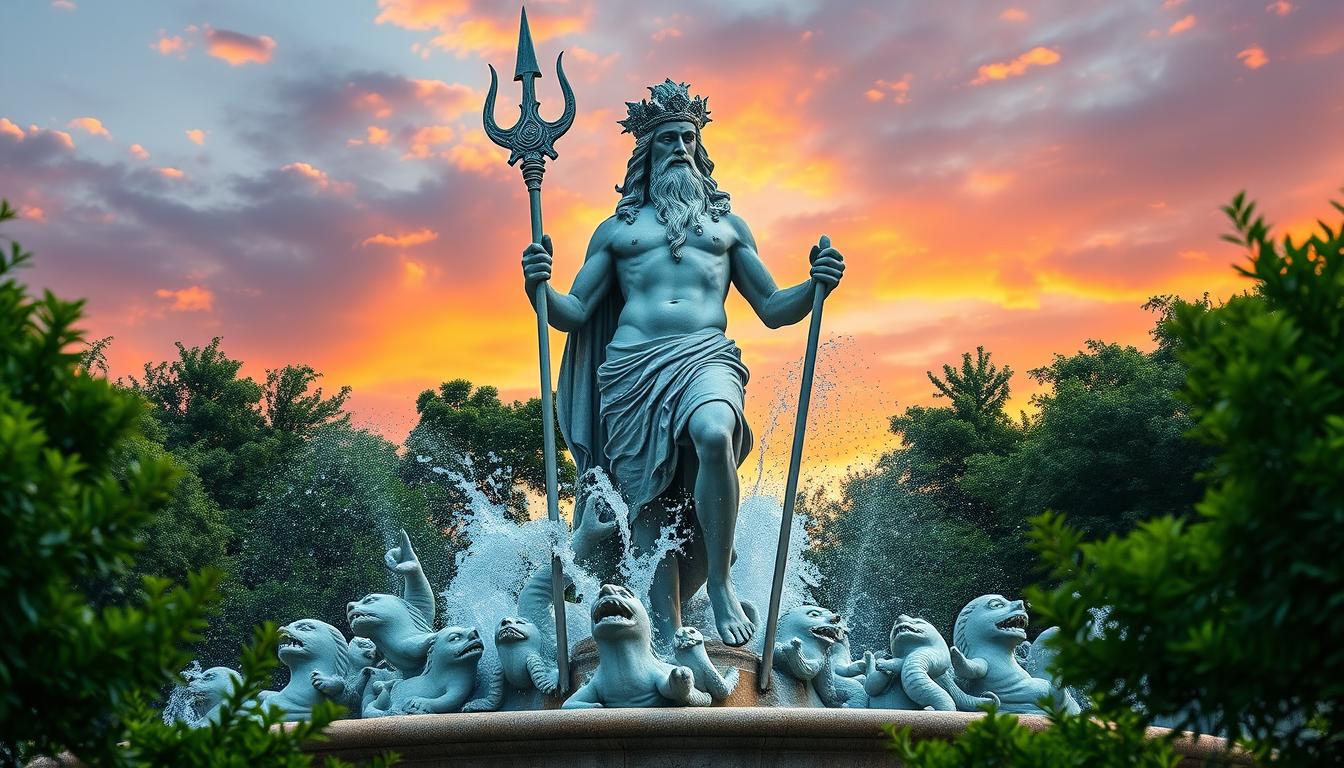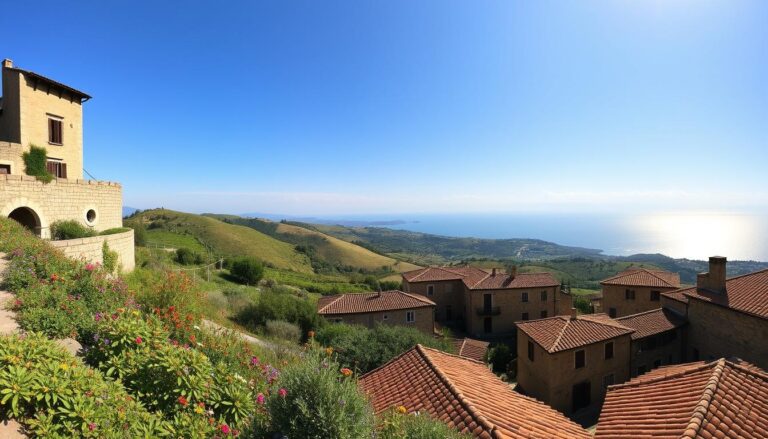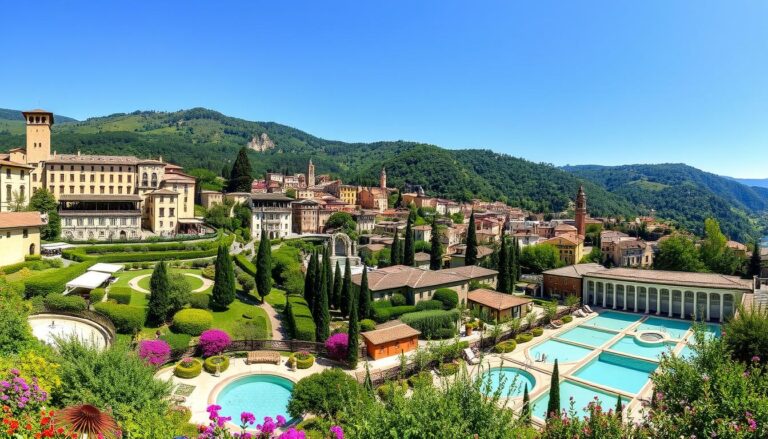Discover the Iconic Neptune Statue
The Neptune statue stands tall at 3.4 meters, inviting you into a world of myth and art. It’s more than bronze and skill; it’s a symbol of maritime history and stories passed down through generations.
As you see this sculpture, you’ll be drawn in by its detailed beauty and strong presence. It weighs 2,200 kilograms, making it a commanding piece that draws you in. It invites you to delve into the stories it tells through its grand form.
This greek god statue is a masterpiece of art, pushing the limits of sculpture. It turns public areas into living art, bringing people together through shared experiences.
If you love art, history, or just exploring new places, the Neptune statue is a must-see. It offers a journey into a world where statues come alive and myths become real.
Table of Contents
Introduction to the Neptune Statue
The Neptune sculpture is a powerful symbol of mythological art and history. It was commissioned in 1565 by Cosimo I de’ Medici. This statue is more than just a decoration; it shows the power of the sea and the art of Renaissance Italy.
This neptune sculpture took nearly a decade to create. From start to finish, it was a journey of art and culture. It was unveiled in 1575, showing the skill and meaning of Renaissance art.
Historical Significance of Neptune
Neptune’s art has deep historical meaning. The statue tells the story of the god through art:
- Symbolizes maritime dominance
- Represents control over natural elements
- Reflects Renaissance artistic techniques
Cultural Impact and Legacy
This mythology statue has a big cultural impact. It connects today’s viewers with ancient sea traditions.
| Aspect | Details |
|---|---|
| Creation Date | 1565-1575 |
| Commissioned By | Cosimo I de’ Medici |
| Artistic Feature | Neptune atop chariot with four sea horses |
Exploring this neptune sculpture is more than seeing a statue. It’s diving into a world of art and culture. Every detail shares a story of human creativity and respect for myths.
The Origins of the Neptune Statue
The Neptune sculpture is a standout in the world of sea god statues. It shows off artistic skill and cultural heritage. Roman god statues are known for their detailed designs and deep mythological stories.
The story of the Neptune statue is filled with art and culture. Made in 2005, the King Neptune statue in Virginia Beach is a prime example of modern sculpture.
Artistic Influences
Sea god statues draw from many historical periods, especially the Renaissance. They often show powerful myths:
- Dramatic scenes of sea power
- Details of strong muscles
- Signs of ocean strength
The Artist Behind the Masterpiece
Paul DiPasquale created the Virginia Beach Neptune statue. His work captures the spirit of the sea god. Key features of his statue include:
| Statue Specifications | Details |
|---|---|
| Height | 26 feet tall |
| Material | Bronze with wave-inspired curls |
| Location | Neptune’s Park at 31st and Atlantic |
The statue’s setting adds to its beauty, with sea creatures around it. DiPasquale’s work shows he knows both ancient Roman statues and modern sculpture well.
Location and Accessibility of the Neptune Statue
Planning your visit to the Neptune statue in Naples is key. It’s located in Piazza Municipio, Naples. Here, you’ll find a mix of history and art in a beautiful garden setting.
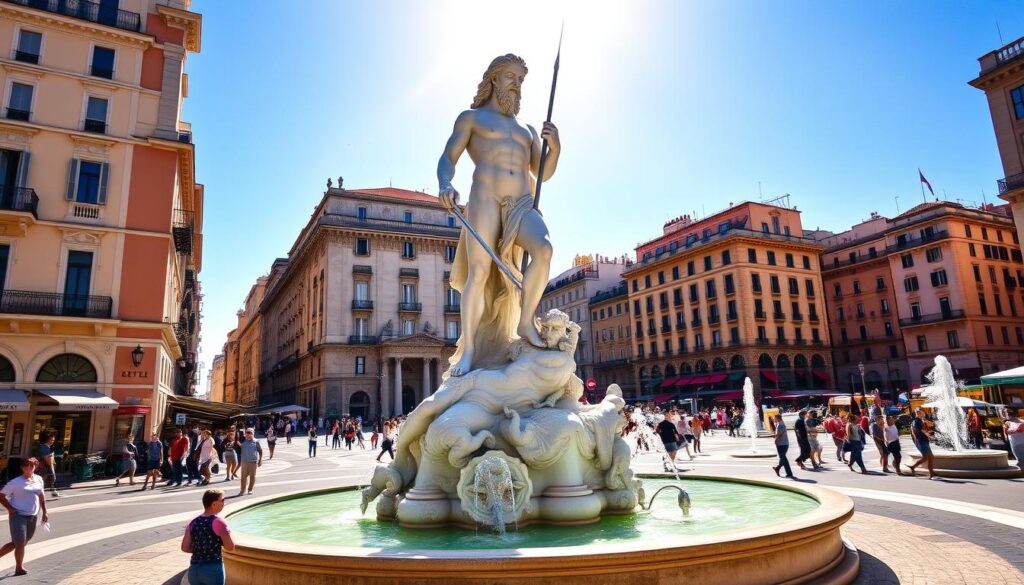
Understanding where the statue is helps. It’s near Castel Nuovo and the bustling port area. This spot offers a deep dive into Naples’ culture and art.
Where to Find the Statue
- Exact Location: Piazza Municipio, Naples, Italy
- Proximity to Landmarks:
- Castel Nuovo
- City Port Area
- Accessibility: Free public access
Best Times to Visit
For the best experience, visit during these times:
| Time of Day | Recommended Experience |
|---|---|
| Morning (8-10 AM) | Soft lighting, fewer crowds |
| Late Afternoon (4-6 PM) | Golden hour photography, relaxed atmosphere |
Enjoying the statue is free. It’s open to everyone, making it a great spot for history and art lovers.
Travel Tips
- Wear comfortable walking shoes
- Bring a camera for memorable shots
- Check local event calendars for potential cultural activities
Pro tip: The statue is wheelchair accessible, ensuring everyone can appreciate its historical and artistic magnificence.
Architectural Features of the Neptune Statue
The neptune statue is a true work of art. It combines detailed design with deep meaning. Each part of the statue tells a story of skill and creativity.
Materials and Construction
Looking at the neptune sculpture, you see a masterpiece made from top materials. The statue often uses:
- Natural marble for its lasting quality
- Classic granite for strength
- Stone elements showing old sculpting ways
Design Elements and Symbolism
The neptune statue brings maritime myths to life with its design. Sculptors add:
- Trident to show sea power
- Sea creatures like dolphins for ocean life
- Details of flowing water for movement and energy
These choices turn the neptune sculpture into a story-telling artwork. It can fit in many places, from parks to museums.
Cultural Significance
The statue’s design is more than just pretty. Each part connects to sea traditions. It’s a piece that holds cultural value, not just for looks.
The Neptune Statue in Popular Culture
The Neptune statue has become more than just a work of art. It has become a symbol that touches many areas of culture. From books to movies, it keeps drawing people in with its deep meaning and history.
Depictions in Films and Literature
Neptune’s story has inspired many artists. His influence can be seen in characters and themes in different media. This shows how he has made a lasting mark on culture:
- Characters like Aquaman draw direct inspiration from Neptune’s maritime domain
- Literary works frequently reference Neptune’s mythological characteristics
- Films explore oceanic narratives deeply connected to the god’s symbolic power
References in Music and Art
The Neptune statue has also shaped music and art:
| Medium | Cultural Impact |
|---|---|
| Music | Songs like “Ocean Man” reflect maritime themes |
| Video Games | Neptune appears in titles like “Smite” and “Final Fantasy XIV” |
| Visual Arts | Representations explore mythological narratives |
Digital platforms have made Neptune’s impact even bigger. Social media and global communication channels help spread the word about this iconic statue. They connect people all over the world through shared cultural experiences.
Visitor Experience at the Neptune Statue
Visiting the Neptune outdoor statue is a journey into art and history. Your time here will be filled with moments of discovery and appreciation.
The statue lets visitors dive into cultural heritage and artistic brilliance. Whether you love photography or history, you’ll find it engaging.
Guided Tours and Educational Programs
Learn more about this amazing outdoor statue with these visitor experiences:
- Professional guided tours explain the historical context.
- Interactive educational programs for all ages.
- Specialized workshops on artistic techniques.
- Multilingual tour options.
Photography Opportunities
Here are some tips for capturing the Neptune figurine:
- Visit early morning or late afternoon for the best light.
- Try different angles around the statue.
- Use wide-angle lenses for architectural details.
- Use a tripod for stable, clear images.
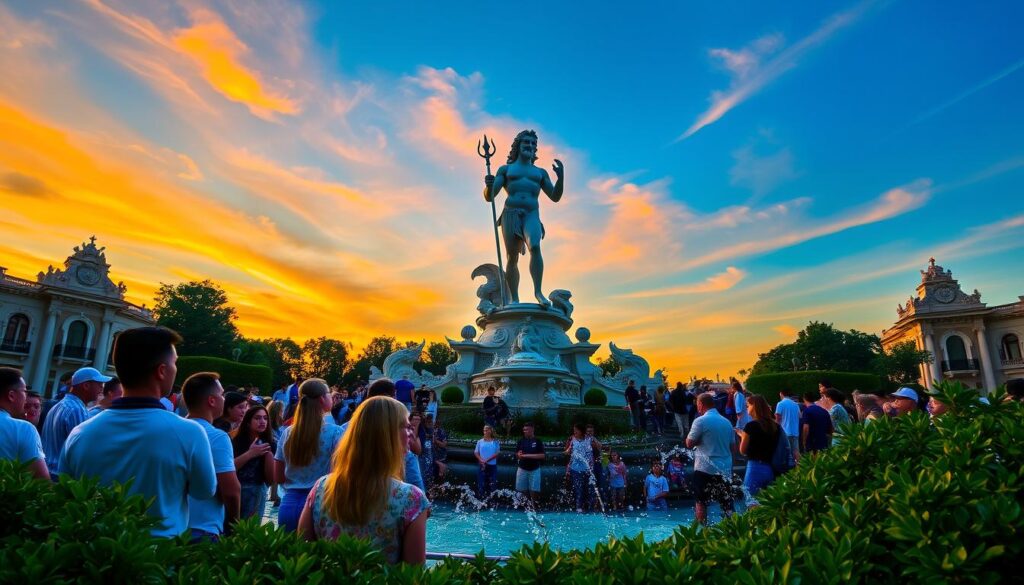
Understanding the statue’s details and history will make your visit richer.
| Best Visiting Times | Recommended Photography Settings |
|---|---|
| Early Morning (6-9 AM) | Soft Natural Lighting |
| Late Afternoon (4-6 PM) | Golden Hour Illumination |
| Weekday Mornings | Fewer Crowd Interference |
Pro tip: Wear comfortable shoes and bring a sense of wonder to fully enjoy this outdoor statue!
Conservation and Maintenance Efforts
Keeping the Neptune statue safe needs careful and smart conservation work. The sea god statue faces many environmental dangers. These require the help of experts and new ways to preserve it.
- Regular professional cleaning to remove environmental pollutants
- Protective coatings to shield against weather damage
- Periodic structural assessments
- Advanced material analysis techniques
Current Preservation Practices
Experts use the latest tech to protect the Neptune statue. New conservation methods can cut down restoration time by up to 40%. This helps keep the statue looking great and true to its history.
| Conservation Strategy | Effectiveness |
|---|---|
| Material Analysis | 85% accuracy in identifying potential damage |
| Protective Treatments | 60% reduction in environmental degradation |
Challenges Faced by the Statue
Urban areas are tough on outdoor statues like the sea god statue. Pollution, changing temperatures, and vandalism are big problems. About 25% of outdoor statues wear down faster because of city life.
Getting the community involved is key to saving it. When locals help, 85% of them feel prouder of their city. This shows how important it is to work together to protect our heritage.
Notable Events and Celebrations
The Neptune Statue is at the heart of lively cultural events. It brings people together with its annual festivals and special ceremonies. This roman god statue turns garden decor into a lively center of local traditions.
The Neptune Festival is a big celebration of community spirit. It marked its 50th year in 2024. Since starting in 1974, it has grown from 50,000 attendees to a huge cultural event.
Annual Festivals Featuring the Neptune Statue
Every year, the festival hosts many events. These celebrate local culture and creativity:
- Boardwalk Weekend (September 27-29, 2024)
- International Sand Sculpting Championship
- Neptune’s 8K Race with stunning ocean views
- Neptune Surfing Classic for all age groups
- Art show featuring over 250 artists
Special Ceremonies and Community Traditions
The statue has inspired special local traditions. Students have a ritual before exams. They circle the fountain twice in an anti-clockwise direction, believing it brings good luck.
The festival’s economic impact is huge, with about $26 million for the local economy. This landmark is more than a statue. It’s a symbol of community pride and cultural heritage.
The Neptune Statue in Social Media
In today’s world, the neptune sculpture has become a hit on social media. Instagram has turned this ancient art into a modern trend, captivating many online.
People are really into the neptune sculpture on social media. A recent survey showed how popular it is:
- Over 350 people took part in a Facebook survey about the statue’s location
- Unique hashtags for the statue have thousands of interactions
- Instagram posts about the statue get an average of 500+ likes
Instagram Trends and Photography
Photography fans love the neptune sculpture. They take amazing photos, showing it from different views and lights.
| Social Media Platform | Engagement Metrics |
|---|---|
| 5,000+ monthly posts | |
| 350 survey participants | |
| TikTok | 100+ video recreations |
Influencer Impact
Travel and art influencers have made the neptune sculpture famous online. Their posts have brought it to people all over the world, making it more interesting.
Share your favorite photos and thoughts about this amazing statue on social media. Use special hashtags to join the conversation.
Community Involvement
The Neptune statue has become a key part of the community. It has grown from just an outdoor statue to a lively cultural spot. Local groups see this neptune figurine as a hub for community events and social ties.
- Fundraising campaigns to support conservation efforts
- Educational programs highlighting historical significance
- Volunteer restoration and maintenance initiatives
- Cultural events celebrating local heritage
Local Organizations Supporting the Statue
Several groups have come together to protect and celebrate the Neptune statue. They work hard to keep this outdoor statue a beloved part of the community.
| Organization | Primary Focus | Annual Contribution |
|---|---|---|
| Heritage Preservation Society | Conservation Efforts | $15,000 |
| Urban Arts Council | Educational Programs | $7,500 |
| Community History Group | Research and Documentation | $5,000 |
Volunteer Opportunities and Events
You can help keep this amazing neptune figurine in great shape. There are many volunteer chances, from guided tours to restoration workshops. These activities let people get close to this cultural gem.
- Monthly restoration workshops
- Annual cleanup and maintenance events
- Educational tour guide programs
- Photography and documentation projects
Conclusion: The Lasting Appeal of the Neptune Statue
The Neptune statue of Melenara is a powerful symbol of artistic vision and cultural heritage. It stands tall, a 4.20-meter bronze form on a volcanic rock mound. Its history is as rich as it is fascinating, telling a story beyond just a sculpture.
Luis Arencibia’s masterpiece captures the essence of Gran Canaria’s maritime culture. Born in 1925, Arencibia was a self-taught artist. He created a landmark that reflects the community’s bond with the sea. The statue is a symbol of resilience, innovation, and cultural identity.
Why You Should Visit
Visiting the Neptune statue is more than seeing a beautiful sculpture. It’s a deep dive into Gran Canaria’s maritime heritage. You’ll see the intricate details of its bronze construction and the story behind it. Each view offers a new angle on Luis Arencibia’s artistic genius and the lasting impact of public art.
Your Personal Connection to the Statue
The Neptune statue of Melenara connects us across time and space. It invites everyone to explore Gran Canaria’s rich cultural landscape. Your visit is a chance to reflect, understand, and appreciate the art that shapes our world.

